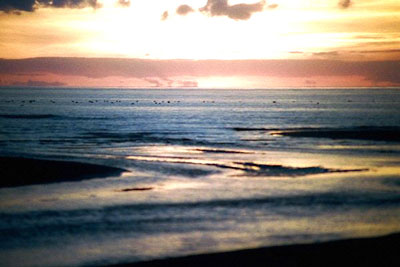 ©FreeFoto.com Solway Firth straddles the Scottish-English border. Mudflats and sandflats dominate the Firth. Most of the flats though, are actually sand rather than muddy which is unusual for an estuary. A lot of the sand and mud is a relic of the last Ice Age. As the Solway is quite sheltered, the surface of the sea can be deceptively calm. However, below the surface, lies an extremely dynamic environment. The Solway's funnel-like shape and shallow depth affect the tidal ebb and flow, creating strong currents. Occasionally, a tidal bore can develop at the head of the Firth. These powerful tides sculpt the soft sediments into sand banks, sand bars, and deep channels. Their positions are largely uncharted as huge quantities of sand and mud can be moved over large distances during a single tidal cycle, making navigation of the Inner Firth treacherous. Most of the Solway Firth is less than 10m (30 ft) deep. The Inner Solway rarely exceeds 5m (15 ft) which is why the large tidal range uncovers such large areas of intertidal flats at low water. Deeper, clearer waters found off the Mull of Galloway, Burrow Head and St. Bees Head are an attraction for sub-aqua divers. However, the large number of wrecks scattered around these headlands are a stark reminder of the dangers posed by the submerged rocks and swift tidal races. Near the head of the Firth, the ebb tide drains remarkably slowly, taking around 6 hours, but when the tide turns it rises extremely rapidly - 4m in just 2 hours. The Solway's sand dunes and salt marshes are home to a remarkable variety of plants and animals, including some unusual and endangered species. The Firth is an important area for fish, with spawning and nursery areas for a number of commercial and rare fish. Over 130 species of fish have been recorded in these waters. Many migrate in and out seasonally, including the famous Solway salmon. Basking Sharks are harmless giants that may be seen basking on the Firth's surface during calm, sunny weather. They only eat microscopic plankton, by sieving seawater through their gill rakers. During exceptional spring blooms, more than a million plankton can occur in one liter of seawater. In winter there is very little plankton, so the sharks shed their gill rakers, stop feeding and retire to deep water until the spring when their gill rakers re-grow. The Solway Firth contains habitats and wildlife of local, national, and international importance. It also supports a considerable proportion of the local economy. However, as increasing demands are made on the Solway, some activities come into conflict with other interests. This has created a challenge for the Solway's communities to manage the Firth's resources in a less fragmented, more sustainable way. It has been a focus of a remarkable variety of human activities and peoples. Celts, Britons, Romans, Angles, Vikings and Normans may have passed into history but all have left their mark on the region's landscape, customs, and traditions. The Solway is an increasingly popular tourist destination. Visitors are attracted by the area's heritage and natural landscape. |